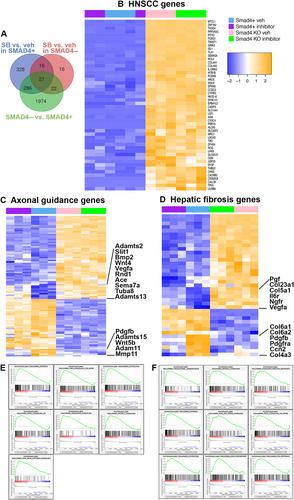下载PDF
{"title":"肿瘤抑制因子 SMAD4 和 WNT 信号在口腔鳞状细胞癌发展过程中的相互作用。","authors":"Jing Yang, James S Lewis, Jinghuan Zi, Thomas Andl, Ethan Lee, Claudia D Andl, Qi Liu, Robert D Beauchamp, Anna L Means","doi":"10.1002/path.6318","DOIUrl":null,"url":null,"abstract":"<p>SMAD4 is a tumor suppressor mutated or silenced in multiple cancers, including oral cavity squamous cell carcinoma (OSCC). Human clinical samples and cell lines, mouse models and organoid culture were used to investigate the role that SMAD4 plays in progression from benign disease to invasive OSCC. Human OSCC lost detectable SMAD4 protein within tumor epithelium in 24% of cases, and this loss correlated with worse progression-free survival independent of other major clinical and pathological features. A mouse model engineered for <i>Kras</i><sup>G12D</sup> expression in the adult oral epithelium induced benign papillomas, however the combination of <i>Kras</i><sup>G12D</sup> with loss of epithelial <i>Smad4</i> expression resulted in rapid development of invasive carcinoma with features of human OSCC. Examination of regulatory pathways in 3D organoid cultures of SMAD4+ and SMAD4− mouse tumors with <i>Kras</i> mutation found that either loss of SMAD4 or inhibition of TGFβ signaling upregulated the WNT pathway and altered the extracellular matrix. The gene signature of the mouse tumor organoids lacking SMAD4 was highly similar to the gene signature of human head and neck squamous cell carcinoma. In summary, this work has uncovered novel mechanisms by which SMAD4 acts as a tumor suppressor in OSCC. © 2024 The Author(s). <i>The Journal of Pathology</i> published by John Wiley & Sons Ltd on behalf of The Pathological Society of Great Britain and Ireland.</p>","PeriodicalId":232,"journal":{"name":"The Journal of Pathology","volume":"264 1","pages":"4-16"},"PeriodicalIF":5.6000,"publicationDate":"2024-06-26","publicationTypes":"Journal Article","fieldsOfStudy":null,"isOpenAccess":false,"openAccessPdf":"https://www.ncbi.nlm.nih.gov/pmc/articles/PMC11300146/pdf/","citationCount":"0","resultStr":"{\"title\":\"Interaction of the tumor suppressor SMAD4 and WNT signaling in progression to oral squamous cell carcinoma\",\"authors\":\"Jing Yang, James S Lewis, Jinghuan Zi, Thomas Andl, Ethan Lee, Claudia D Andl, Qi Liu, Robert D Beauchamp, Anna L Means\",\"doi\":\"10.1002/path.6318\",\"DOIUrl\":null,\"url\":null,\"abstract\":\"<p>SMAD4 is a tumor suppressor mutated or silenced in multiple cancers, including oral cavity squamous cell carcinoma (OSCC). Human clinical samples and cell lines, mouse models and organoid culture were used to investigate the role that SMAD4 plays in progression from benign disease to invasive OSCC. Human OSCC lost detectable SMAD4 protein within tumor epithelium in 24% of cases, and this loss correlated with worse progression-free survival independent of other major clinical and pathological features. A mouse model engineered for <i>Kras</i><sup>G12D</sup> expression in the adult oral epithelium induced benign papillomas, however the combination of <i>Kras</i><sup>G12D</sup> with loss of epithelial <i>Smad4</i> expression resulted in rapid development of invasive carcinoma with features of human OSCC. Examination of regulatory pathways in 3D organoid cultures of SMAD4+ and SMAD4− mouse tumors with <i>Kras</i> mutation found that either loss of SMAD4 or inhibition of TGFβ signaling upregulated the WNT pathway and altered the extracellular matrix. The gene signature of the mouse tumor organoids lacking SMAD4 was highly similar to the gene signature of human head and neck squamous cell carcinoma. In summary, this work has uncovered novel mechanisms by which SMAD4 acts as a tumor suppressor in OSCC. © 2024 The Author(s). <i>The Journal of Pathology</i> published by John Wiley & Sons Ltd on behalf of The Pathological Society of Great Britain and Ireland.</p>\",\"PeriodicalId\":232,\"journal\":{\"name\":\"The Journal of Pathology\",\"volume\":\"264 1\",\"pages\":\"4-16\"},\"PeriodicalIF\":5.6000,\"publicationDate\":\"2024-06-26\",\"publicationTypes\":\"Journal Article\",\"fieldsOfStudy\":null,\"isOpenAccess\":false,\"openAccessPdf\":\"https://www.ncbi.nlm.nih.gov/pmc/articles/PMC11300146/pdf/\",\"citationCount\":\"0\",\"resultStr\":null,\"platform\":\"Semanticscholar\",\"paperid\":null,\"PeriodicalName\":\"The Journal of Pathology\",\"FirstCategoryId\":\"3\",\"ListUrlMain\":\"https://onlinelibrary.wiley.com/doi/10.1002/path.6318\",\"RegionNum\":2,\"RegionCategory\":\"医学\",\"ArticlePicture\":[],\"TitleCN\":null,\"AbstractTextCN\":null,\"PMCID\":null,\"EPubDate\":\"\",\"PubModel\":\"\",\"JCR\":\"Q1\",\"JCRName\":\"ONCOLOGY\",\"Score\":null,\"Total\":0}","platform":"Semanticscholar","paperid":null,"PeriodicalName":"The Journal of Pathology","FirstCategoryId":"3","ListUrlMain":"https://onlinelibrary.wiley.com/doi/10.1002/path.6318","RegionNum":2,"RegionCategory":"医学","ArticlePicture":[],"TitleCN":null,"AbstractTextCN":null,"PMCID":null,"EPubDate":"","PubModel":"","JCR":"Q1","JCRName":"ONCOLOGY","Score":null,"Total":0}
引用次数: 0
引用
批量引用



